60 Latest Video Marketing Statistics For 2024: The Complete List

In light of the rapid growth of online video consumption over the last few years, video has become a content medium that brands can no longer afford to ignore. It’s now an irreplaceable part of most marketing strategies.
In this post, we’ll take a look at some video marketing statistics that show just how popular video has become amongst both consumers and marketers, and that shed useful insights you can apply to your video marketing strategy.
We’ll learn more about platforms, audiences, trends, and challenges shaping the video marketing industry.
Editor’s top picks – video marketing statistics
These are our most interesting statistics about video marketing:
- 86% of businesses utilize video marketing. (Source: Wyzowl)
- The total time spent watching videos increased by around 249% in 5 years. (Source: Wistia)
- 22% of marketers create a few videos per week. (Source: Biteable)
Key video marketing statistics
First off, let’s take a look at some of the most important video marketing statistics you need to know.
These stats tell us more about the current usage/adoption of video marketing amongst businesses, and the recent growth in consumption of video content amongst consumers.
1. 86% of businesses utilize video marketing
This is the percentage of businesses that used video as a marketing tool in 2021. It’s hovered around the same mark for the last few years, having been at 85% in 2020 and 87% in 2019. However, it’s up substantially from 61% in 2016.
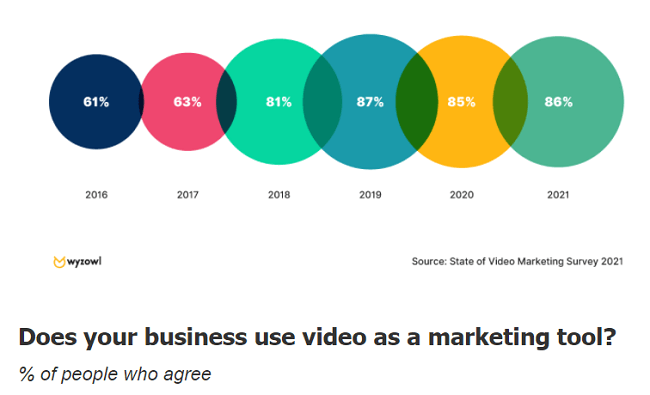
Source: Wyzowl
2. 50% of those who use video marketing have been doing so for at least a year
This is according to data by Biteable. It also means that the other 50% of video marketers have only recently started using video, and shows just how quickly video marketing is growing in popularity.
Wyzowl reported separately that 24% of marketers only started using video in 2020, and that 51% of those new to video marketing said they jumped on the bandwagon as creating videos had become easier, while 47% said it was a way to respond to new challenges such as the pandemic.

Source: Biteable and Wyzowl
3. 94% of video marketing plan to continue using video in the future
As this stat shows, the sudden popularity of video marketing doesn’t seem to be a ‘flash in the pan’, either. The vast majority of marketers plan to continue to use video long into the future.

Source: Biteable
4. Video uploads have increased by 263.4% in 5 years
This is according to data gathered by Wistia and specifically refers to videos uploaded to their platform. The growth of uploads on the platform represents a much wider trend.
Interestingly, the largest jump in uploads came between 2019 and 2020, with the total number of video files created almost doubling from around 9 million to 17.5 million. This is compared to a much smaller increase of just 32% the year before and suggests the global pandemic may have accelerated video marketing adoption.
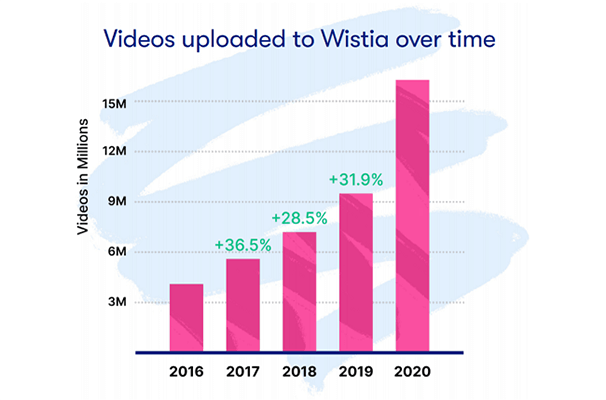
Source: Wistia
5. 32% of businesses use video as a sales tool
Other popular non-marketing uses of video content include use in administration and operations messages (29%), human resources messages (27%), leadership messages (24%), product management (20%), and customer support (19%).

Source: Biteable
6. The total time spent watching videos increased by around 249% in 5 years
Total watch time rose from 3.5 billion minutes to 12.2 billion minutes (which is around 23,211 years) from 2016 to 2020. The biggest jump came between 2019 and 2020: an 84.8% increase. This huge jump was likely due indirectly to the pandemic, as national lockdown meant consumers spent more time at home consuming content.
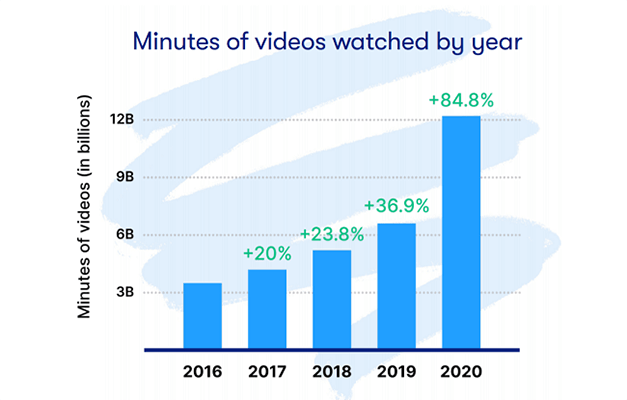
Source: Wistia
7. 96% of consumers say they’ve watched more video content online due to the pandemic
This stat further proves that recent events have rapidly accelerated video consumption. The vast majority of consumers admit to watching more since the onset of the pandemic.
Source: Wyzowl
Video marketing effectiveness and benefits
One of the most important questions decision-makers want to know before they invest in video marketing is what kind of returns they can expect. Here are some statistics that shed some light on that question by revealing more about its many benefits.
8. 87% of marketers think video provides a positive return on investment (ROI)
If you were still on the fence about whether it’s worth investing in video, this stat should help to convince you. That many marketers can’t all be wrong, right?
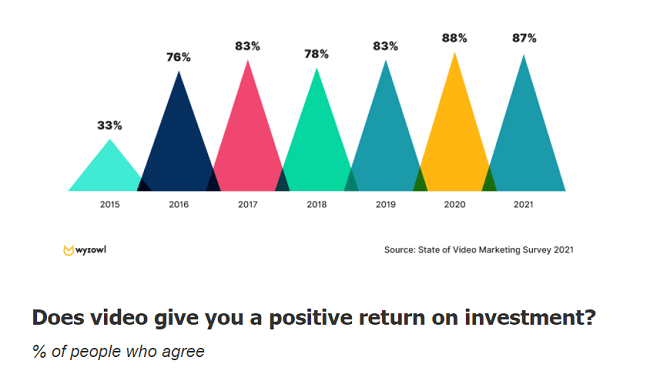
Source: Wyzowl
9. 74% of marketers think video has a greater ROI than static imagery
Static imagery means any visual content that doesn’t move. We’re talking about infographics, photos, etc.
Source: Biteable
10. 68% of marketers think video has a greater ROI than Google Ads
That’s right, video content may be able to produce even better returns per dollar spent than paid ad campaigns.
Source: Biteable
11. Over 60% of marketers consider video to be very/extremely important to their marketing strategy
This is according to a recent survey of 694 marketers and small business owners.
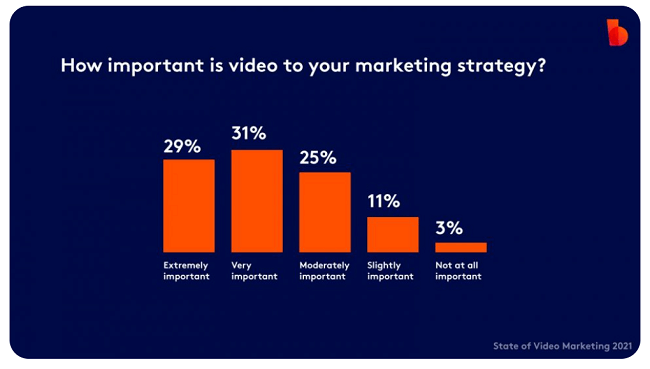
Source: Biteable
12. 63% of marketers look at video engagement to measure success
Measuring the success of marketing campaigns is always a challenge. When it comes to video marketing, 63% of marketers look at engagement metrics like shares, comments, likes to get an idea of their performance, while 58% consider overall reach to be the most important market of success. Interestingly, only 29% looked at sales to measure success.
Source: Wyzowl
13. 84% of video marketers think video has helped with lead generation
Lead generation involves finding new potential customers, capturing their interest in your product/service, and getting them into your sales funnel.
Source: Wyzowl
14. 86% of video marketers say video has boosted their website traffic
Publishing videos can be a great way to drive more organic traffic to your website. This figure is up by 1% from last year.
Source: Wyzowl
15. 53% of marketers say video is great for building awareness
Aside from building traffic, video can also be great for reaching large audiences and building awareness of your brand.
Source: Biteable
16. 49% of marketers think video is effective at engaging audiences
As this stat shows, almost half of all marketers think video is a great tool to improve audience engagement.
Source: Biteable
17. 52% of marketers think video helps build customer trust
If improving trust in your brand is one of your main marketing goals, video can help.
Source: Biteable
18. 83% of marketers think video has increased their visitors’ average time on page
Videos are more engaging than long walls of text. As such, including videos on your posts and pages can help to encourage your customers to stick around and boost time spent on page.
Source: Wyzowl
19. 94% think video has increased their customers understanding of their business
Many businesses use video as a way to inform customers about their products or services. Explainer videos, how-to videos, and product tutorials are especially effective at this.
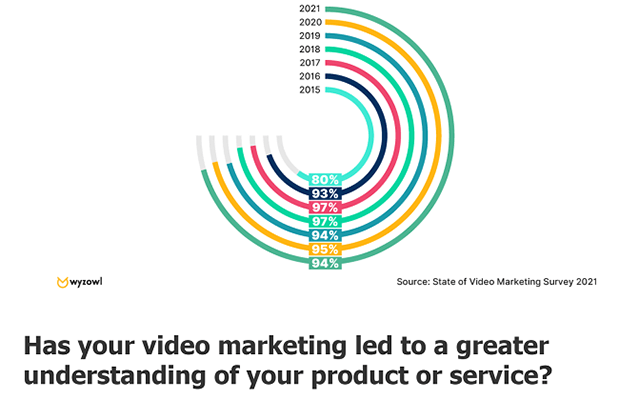
Source: Wyzowl
20. 78% of video marketers think it’s had a direct positive impact on sales
Even though most marketers don’t look to sales figures as a marker of the success of their video marketing campaigns, this stat shows that it can still help to boost sales figures.
Source: Wyzowl
21. 43% of video marketers think video has reduced the number of support calls
Providing how-to videos and tutorials on your website knowledge base can be a great way to provide visual support to your customers so that there’s less need for phone support.
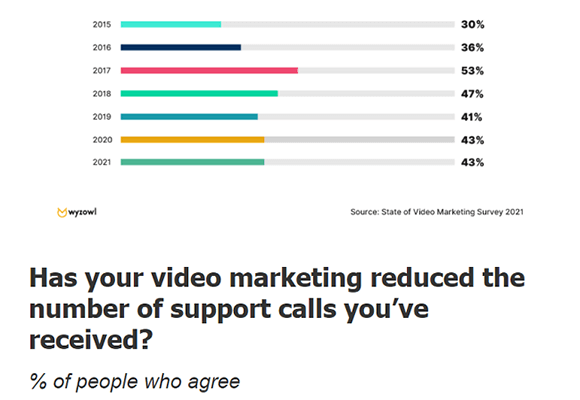
Source: Wyzowl
Video marketing audience statistics
The video marketing statistics below tell us more about the audiences that are watching videos, how often they’re watching them, and why they’re watching them.
22. People consumer 18 hours of video each week, on average
That works out at around 2.5 hours per day. It’s also 2 hours more per week than a year ago and an increase of around 7.5 hours per week over the last 3 years.
Source: Wyzowl
23. 96% of consumers have watched explainer videos to learn about a product or service
Explainer videos are short-form (often animated) videos used in marketing and sales to highlight a company’s product or business idea in a compelling, easy-to-digest way.
Source: Wyzowl
24. 84% of people have made a purchase after watching a brand’s video
Videos provide visual context and detailed information about products that can help provide customers with everything they need to make an informed purchase decision.
Source: Wyzowl
25. 69% of people prefer watching short videos to learn about a product/service
This makes it the people’s preferred way to receive product information. Only 18% of people would rather learn more by reading a text-based page or post, 4% by viewing an infographic, 3% by reading an ebook or attending a webinar, and 2% through a sales call or demo.
Source: Wyzowl
26. Audiences are twice as likely to share video content
This is compared to any other type of content, such as social posts, blog posts, etc.
Source: Wyzowl
Video creation statistics
Here are some video creation statistics that tell us more about how marketers make video content, and the costs involved.
27. 22% of marketers create a few videos per week
… and 14% even make videos every single day!

Source: Biteable
28. 39% of marketers create their own video content in-house
More marketers produce their own video content than outsource it. Only 17% fully outsource video creation.
Source: Biteable
29. 58% of marketers use professional software to create videos
Part of the reason video marketing is becoming more prevalent is due to technological advancements. Professional video software now makes it much easier, cheaper, and faster for brands to create their own video content.
Source: Biteable
30. 38% of marketers create videos from their smartphones
Interestingly, more than a third of marketers use smartphone apps to create videos, rather than using their desktops. This just goes to show how far smartphone technology has come.
Source: Biteable
31. 48% of marketers make some videos from scratch and others using pre-made templates
Only 18% use pre-made templates all the time, while 35% make videos from scratch each time.
Source: Biteable
32. The majority of marketers spend up to $1000 per video
Creating video content isn’t cheap. To produce just 10 videos, you should expect to pay anywhere from $1000 to $10,000 USD.
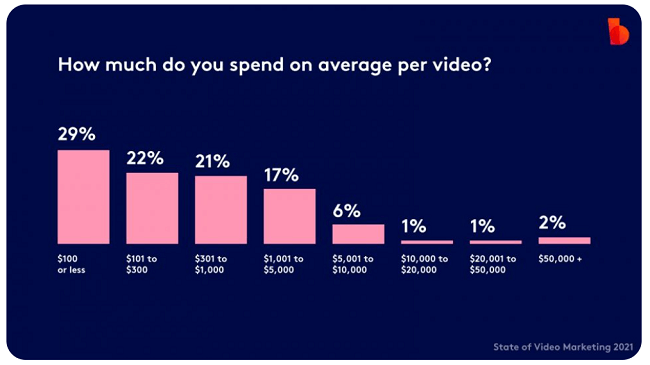
Source: Biteable
33. Most marketers spent under $300 on video in 2020
This year, 23% of marketers spent under $300, which is more than any other spending bracket.
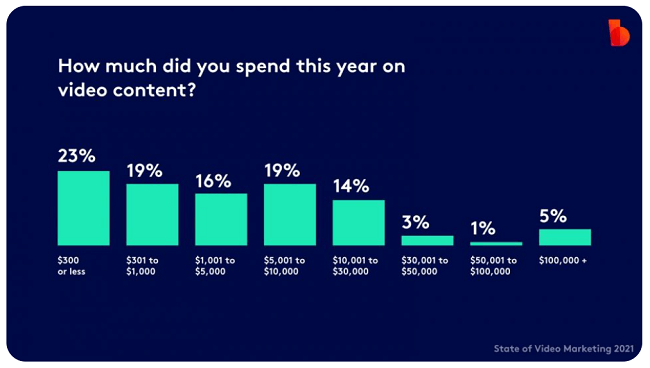
Source: Biteable
34. 65% of marketing videos created are presentations
This makes presentation the most common video format amongst marketers. The second most popular type of video content is advertisements (57%), followed by explainer videos (47%).
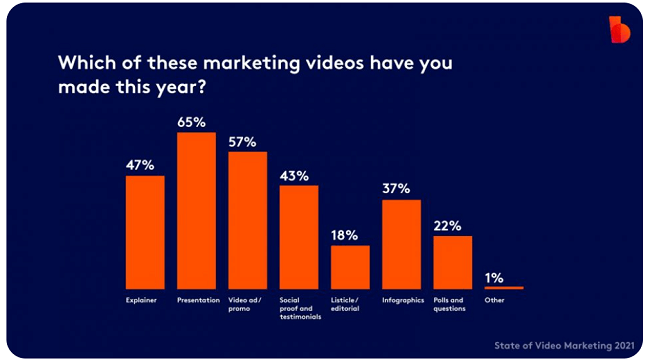
Source: Biteable
Video marketing platforms and channels statistics
Next, let’s look at some video marketing statistics about the platforms and channels most commonly used to distribute video content.
35. 60% of people prefer online video platforms to live TV
Not only that but by 2025, it’s estimated that half of all viewers under age 32 won’t subscribe to a paid TV service at all.

Source: Google
36. YouTube is the platform with the greatest ROI for video content
Unsurprisingly given that it’s the second biggest website on the planet, 35% of marketers think YouTube provides the best returns on their investment. If you’re not publishing your brands’ video content on YouTube, you should be.
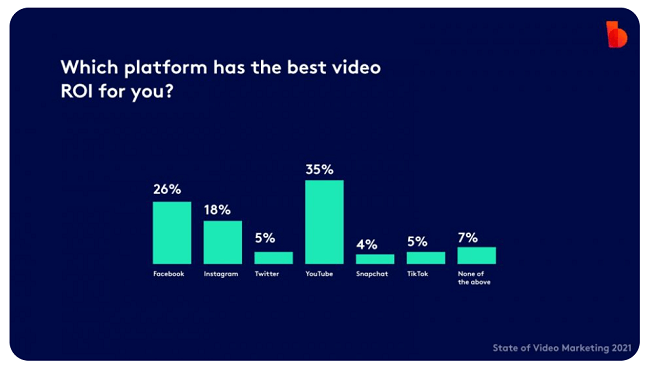
Source: Biteable
37. 87% of marketers say YouTube is an effective channel for them
Again, this just goes to show how YouTube is a video platform that marketers can’t afford to ignore.
Source: Wyzowl
38. 70% of marketers publish their videos to YouTube
More than half of marketers publish their videos to YouTube. However, this is actually a little lower than you might expect, given that…
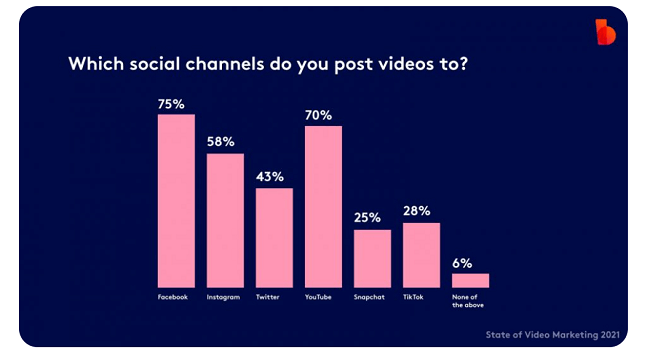
Source: Biteable
39. 75% of video marketers post videos to Facebook
Making Facebook the marketers’ top choice when it comes to social media platforms to post videos to. It’s more popular than both YouTube (70%) and Instagram (58%).
Source: Biteable
40. 70% of video marketers plan to use Facebook in their strategy this year
This is actually down by 6% from last year and may reflect the falling popularity of Facebook amongst the younger generation of consumers.
However, Facebook isn’t the only platform to see a drop in usage amongst video marketers this year. Most other social platforms saw similar declines.
For example, 63% of video marketers plan on using LinkedIn this year (down by 3%), 58% plan to use Instagram (down by 7%), 31% plan to use Twitter (down by 7%). Only TikTok saw an increase in use by video marketers this year.
Source: Wyzowl
41. 85% of Facebook videos are watched with the sound off
The upshot: don’t rely on audio to get your message across. Make sure your videos are captioned or make sense without sound.
Source: Digiday
Note: Want to learn more? Check out our roundup of Facebook video statistics.
42. Tweets with videos generate 10x the engagement
Twitter’s never been a very popular video marketing channel but as this stat shows, including video in your Tweets can definitely boost your engagement on the platform.
Source: Twitter
43. 20% of marketers distribute content on TikTok
This is up from 10% in 2019. However, it’s still very low compared to other platforms. Despite TikTok being one of the most popular video-sharing social platforms (and one that’s growing rapidly), it’s still not popular amongst marketers.
Source: Wyzowl
44. Only 6% of video marketers plan to use Snapchat video
Snapchat remains another one of the least popular platforms amongst video marketers. It’s even less popular this year (6%) than last year (9%).
Source: Wyzowl
45. 34% of marketers publish video content to social platforms in the afternoon
This makes afternoon the most popular time of day to post videos on social platforms. It’s followed by evening (25%) and then morning (22%). Only 2% of marketers post video content to social media at night.
46. 62% of marketers used webinars to distribute video in 2020
This is up from 46% in 2019. What’s more, 91% of marketers think their webinars have been a huge success. This makes it the most effective distribution channel of 2020.
Source: Wyzowl
Video marketing tips, benchmarks, and best practices
Next, we’ll share some statistics that provide useful tips which you can apply to your video marketing campaigns.
47. 81% of marketers think videos that include music perform better
And a further 66% think videos perform better when they include a voiceover. The takeaway: make sure you think carefully about audio.
Source: Biteable
48. 64% of marketers think videos that include captions perform better
Captions provide a way for audiences to follow the dialogue in your video even with the sound off.
Source: Biteable
49. 65% of marketers think it’s very important to show diversity in videos
Consumers care about diversity. If you want to show your brand in a positive light, consider this when creating your video content.
Source: Biteable
50. Interactive elements placed at the start of videos generate the highest conversion rates
55% of interactive elements used in videos are placed at the start, and for good reason.
Over the last 5 years, interactive elements placed at the end of videos have generated an average conversion rate of 8.7%, compared to 7.9% when placed at the start, and 3% in the middle. However, this is just the 5-year average. If we look at just the data from 2020, it tells a different story.
In 2020, interactive elements placed at the start seem to be far more effective, generating a 12.7% conversion rate compared to just 6.8% when placed at the end.
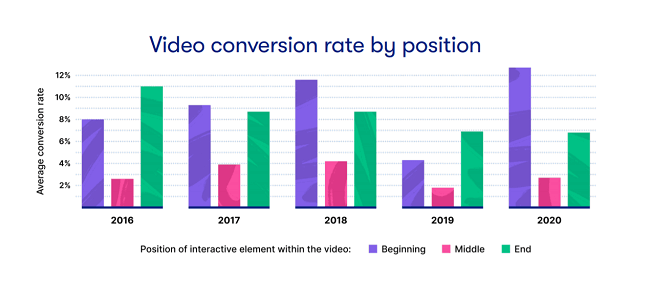
Source: Wistia
51. The average engagement rate of short-form videos is around 50%
To be specific, videos under 1 minute generated an average engagement rate of 53.9%. Meanwhile, those between 1 and 3 minutes long averaged 50.6%, and those between 3 and 5 minutes averaged 48.9%. Engagement rates only start to drop substantially as we enter the 5-30 minute mark.
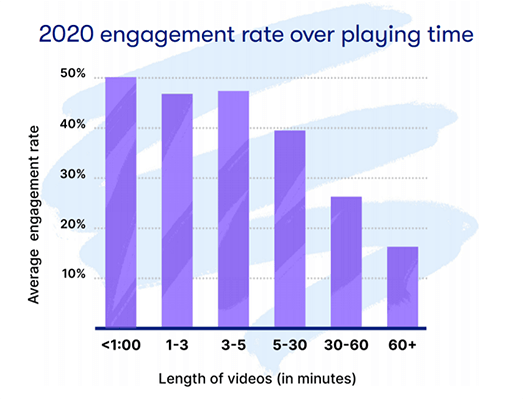
Source: Wistia
52. The average engagement rate of long-form videos (60+ minutes) is around 17%
Audiences seem to have a limited attention span when it comes to videos. The upshot: if you want to see higher engagement rates, focus on short-form content.
Source: Wistia
Video marketing trends
Here are a handful of stats that reveal recent trends that are changing the way we create, distribute, and consume video content.
53. Over three-quarters of videos are now watched on mobile
One clear trend over the last few years is the growth of mobile content consumption. 78.4% of digital video viewers watch content on their mobile devices, according to forecasts by eMarketer.
Source: eMarketer
54. Short-form videos are the most commonly created, but long-form videos are catching up
In 2020, around 4.8m videos under a minute in length were uploaded to the Wistia platform, compared to just 2m in the 1-3 minutes category, and only 795k in the 30-60 minutes category.
However, while the overall volume of long-form videos being published to Wistia is still low, the evidence suggests they’re gaining traction.
Over 5 years, the number of long-form videos (30-60 minutes) being created increased by 446%, and those between 5 and 30 minutes increased by 288%. Comparatively, short videos that were 0-1 minutes in length only increased by 100.3%.

Source: Wistia
55. Google now shows video thumbnails in 26% of search results
Another trend we’ve seen over the last few years is the increasing use of video content within SEO strategies. Publishing video content can help you to rank for competitive keywords in the Google search results snippets.
This is an important SEO statistic for those of you who want to improve your organic search strategy.
Source: BrightEdge
56. 40% of marketers said their video marketing strategy has been affected by the pandemic
91% of them now feel video is more important for brands, 74% of those affected say the pandemic has made them more likely to invest in video content, and 26% say it made them less likely.
Source: Wyzowl
Video marketing challenges
Most businesses now utilize video marketing. However, those that don’t often cite specific barriers and challenges. Here are some statistics that tell us more about those challenges.
57. 66% of marketers don’t make videos as they think it takes too much time
Creating a video takes a lot more time than writing a blog post. For some businesses, the time investment required outweighs the benefits.
Source: Biteable
58. 37% of marketers think making videos is too expensive
There are costs involved in purchasing recording equipment, editing videos, creating animations, and hiring voiceover artists and actors. It all quickly adds up!
Source: Biteable
59. 41% of marketers don’t create videos as they think it’s too complicated…
Many marketers don’t feel that creating videos is their area of specialty, and investing time into learning all the skills and knowledge required to create top-notch videos is out of the question for some.
Source: Biteable
60. …But 80% would create more videos if there was an easier way
This shows there’s a huge demand out there for software and services that make creating video content easier and more affordable.
Source: Biteable
Video marketing statistic sources
Final thoughts
That concludes our roundup of video marketing statistics and trends.
We hope you found these data-driven insights useful and that you can put them to good use in your future video marketing campaigns.
If you’re interested in checking out more marketing statistics, I’d recommend these:
